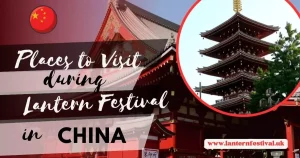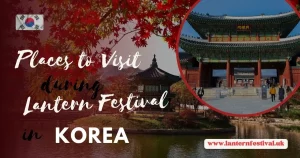The Lantern Festival, also known as the Yuanxiao Festival or Shangyuan Festival, is one of the most beloved holidays in China. Celebrated on the 15th day of the first lunar month (usually in February or early March), it marks the end of the Chinese New Year festivities and symbolizes the coming of spring.
During this magical event, people light thousands of colorful lanterns and release them into the sky or on water, creating a stunning visual spectacle that embodies hope, joy, and unity.
But what are the origins of this unusual tradition? What do the lanterns represent, and how are they made? Join us as we delve into the history and culture of the Lantern Festival and discover why it continues to captivate people around the world.
Table of Contents
History and Origins of the Lantern Festival: A Journey Through Time
The Chinese Lantern Festival is a colorful and vibrant celebration that marks the end of the Chinese New Year festivities. It is a time when families and friends come together to feast, exchange greetings, and admire the glowing lanterns that adorn the streets and homes.
But do you know the complete history and origins of the Chinese Lantern Festival?
In this article, we will take you on a journey through time, exploring the festival’s fascinating history and cultural significance.
Ancient Beginnings
The Lantern Festival has its roots in the Han Dynasty (206 BCE – 220 CE), during the reign of Emperor Hanmingdi. It is believed that the festival began as a way to honor Buddha.
Emperor Hanmingdi, a devout Buddhist, ordered the lighting of lanterns in temples and palaces to show respect to Buddha on the 15th day of the first lunar month. This practice gradually spread to the general population, evolving into a widespread celebration.
Another theory traces the festival’s origins to the Eastern Han Dynasty (25–220 CE), when it was associated with Taoism.
The 15th day of the first lunar month was considered the birthday of Tianguan, the Taoist deity responsible for good fortune. People lit lanterns to pray for blessings and a prosperous year ahead.
The Legend of the Lantern Festival
The Lantern Festival is also intertwined with captivating legends that have been passed down through generations. One of the most popular stories is the Legend of the Jade Emperor’s Favorite Crane.
According to the tale, a heavenly crane descended to Earth and was killed by villagers. Enraged, the Jade Emperor planned to destroy the village with fire on the 15th day of the lunar month.
A wise villager suggested that everyone hang red lanterns, light fires, and set off fireworks to make it appear as though the village was already ablaze. The Jade Emperor, deceived by the spectacle, spared the village. Since then, people have celebrated by lighting lanterns and fireworks on this day.
Another beloved legend is the Romantic Tale of Yuanxiao. Yuanxiao, a palace maid during the Han Dynasty, was homesick and unable to visit her family. A minister named Dongfang Shuo devised a plan to help her.
He spread a rumor that the God of Fire would burn down the city, and the only way to prevent it was for the emperor to order lanterns to be hung throughout the city and for everyone to eat sweet dumplings (tangyuan).
The plan worked, and Yuanxiao was reunited with her family. This story is said to have inspired the tradition of eating tangyuan during the festival.
Evolution of the Festival
Over the centuries, the Lantern Festival has evolved, incorporating various cultural elements and regional customs. During the Tang Dynasty (618–907 CE), the festival became a grand celebration, with lantern displays, performances, and public gatherings. It was a time for people to enjoy the arts, poetry, and music.
By the Song Dynasty (960–1279 CE), the festival had grown even more elaborate. Lanterns became more intricate, often featuring riddles written on them.
Solving these riddles became a popular activity, adding an intellectual dimension to the celebrations. The tradition of eating tangyuan also became firmly established during this period.
Symbolism and Traditions
The Lantern Festival is rich in symbolism, with each element carrying deep cultural meaning:
- Lanterns: Represent hope, brightness, and the dispelling of darkness. They are also believed to guide lost spirits and bring good luck.
- Tangyuan: These sweet rice balls symbolize family unity and togetherness, as their round shape represents completeness and harmony.
- Riddles: Written on lanterns, riddles encourage intellectual engagement and are a fun way to celebrate wisdom and creativity.
- Fireworks and Dragon Dances: These vibrant displays are believed to ward off evil spirits and bring prosperity.
How is the Lantern Festival Celebrated Today?
Today, the Lantern Festival is celebrated not only in China but also in many other parts of the world with significant Chinese communities. Modern celebrations include:
- Lantern Displays: Cities host grand lantern exhibitions featuring intricate designs, often depicting animals, mythical creatures, and cultural symbols.
- Cultural Performances: Traditional dances, such as the lion dance and dragon dance, are performed to the beat of drums and cymbals.
- Family Gatherings: Families come together to enjoy tangyuan, solve riddles, and admire the lanterns.
- Floating Lanterns: In some regions, people release floating lanterns into rivers or the sky, symbolizing the release of worries and the welcoming of new beginnings.
- Fireworks: Fireworks light up the night sky, adding to the festive atmosphere.
- Temple Fairs: Many temples host fairs with Chinese food stalls, games, and performances, attracting locals and tourists alike.
Frequently Asked Questions
- What is the Lantern Festival?
The Lantern Festival is a traditional Chinese celebration held on the 15th day of the first lunar month, marking the end of the Chinese New Year festivities. It is characterized by lantern displays, tangyuan, riddles, and cultural performances. - Why are lanterns lit during the festival?
Lanterns symbolize hope, brightness, and the dispelling of darkness. They are also believed to guide lost spirits and bring good luck. - What is the significance of tangyuan?
Tangyuan, sweet rice balls, symbolize family unity and togetherness. Their round shape represents completeness and harmony. - How did the Lantern Festival originate?
The festival has its roots in the Han Dynasty, with origins linked to Buddhist and Taoist traditions. It evolved over the centuries, incorporating various cultural elements. - What are lantern riddles?
Lantern riddles are puzzles written on lanterns for people to solve. They add an intellectual and fun element to the celebrations. - Is the Lantern Festival celebrated outside of China?
Yes, the Lantern Festival is celebrated in many countries with significant Chinese communities, including Taiwan, Singapore, Malaysia, and Vietnam. It has also gained popularity in Western cities. - What are some modern ways to celebrate the Lantern Festival?
Modern celebrations include attending lantern displays, solving riddles, enjoying tangyuan, watching cultural performances, and participating in temple fairs. - What is the legend behind the Lantern Festival?
One popular legend involves the Jade Emperor’s plan to destroy a village, which was averted by lighting lanterns and fireworks. Another legend tells the story of Yuanxiao, a palace maid reunited with her family through the festival. - What do dragon and lion dances symbolize?
Dragon and lion dances are believed to ward off evil spirits and bring good fortune and prosperity. - Can non-Chinese people celebrate the Lantern Festival?
Absolutely! The Lantern Festival is a celebration of light and joy that can be enjoyed by people of all cultures. Participating in lantern displays, eating tangyuan, and solving riddles are great ways to join in the festivities.
Conclusion
The Lantern Festival is a testament to the enduring power of light, hope, and community. Its rich history and origins reflect the deep cultural values of unity, wisdom, and renewal.
Whether through the glow of lanterns, the sweetness of tangyuan, or the joy of solving riddles, the festival continues to bring people together, illuminating hearts and minds across generations and borders.
As we celebrate the Lantern Festival, we honor not only its ancient roots but also its timeless message of hope and harmony.







